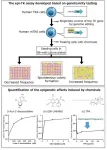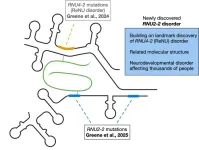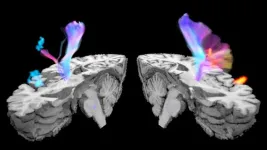(Press-News.org)
Large granular lymphocytic leukemias (LGLLs) are a heterogeneous group of rare chronic lymphoproliferative disorders characterized by the clonal proliferation of cytotoxic lymphocytes. Among them, T-cell LGLL (T-LGLL) and NK-cell LGLL (NK-LGLL) are the most prominent. Due to overlapping morphological, clinical, and immunophenotypic characteristics, distinguishing these disorders from related entities such as T-prolymphocytic leukemia (T-PLL), adult T-cell leukemia/lymphoma (ATLL), Sézary syndrome (SS), and aggressive NK-cell leukemia (ANKL) presents a significant diagnostic challenge. This review integrates recent molecular insights and updates from the WHO 5th edition classification to refine diagnostic precision and inform individualized patient management strategies.
T-cell Large Granular Lymphocytic Leukemia (T-LGLL)
T-LGLL presents with chronic neutropenia, anemia, and autoimmune phenomena—most notably rheumatoid arthritis. Morphologically, cells are small to medium-sized with azurophilic granules. Immunophenotyping reveals a CD8+ cytotoxic profile with frequent expression of CD57, CD16, and granzyme markers. A defining molecular feature is the presence of STAT3 mutations, with STAT5B mutations occasionally observed in CD4+ variants. Clonality is confirmed by T-cell receptor (TCR) gene rearrangement. The WHO’s updated diagnostic criteria emphasize increased circulating cytotoxic T cells, aberrant immunophenotype, and TCR monoclonality, with bone marrow infiltration and STAT mutations as supportive findings. T-LGLL generally has a favorable prognosis when treated with immunosuppressive agents like methotrexate or cyclophosphamide.
Natural Killer-cell Large Granular Lymphocytic Leukemia (NK-LGLL)
NK-LGLL shares many clinical features with T-LGLL, including cytopenias and autoimmune associations, but lacks TCR rearrangement. Morphologically indistinct from T-LGLL, diagnosis hinges on flow cytometric identification of aberrant NK-cell receptor expression (e.g., restricted KIR isoforms, altered CD94/NKG2A). STAT3 and TET2 mutations are common, with unique subtypes defined by CCL22 mutations. Though indolent, treatment is only initiated in symptomatic cases.
T-Prolymphocytic Leukemia (T-PLL)
T-PLL is a highly aggressive peripheral T-cell leukemia. It typically presents with marked lymphocytosis, splenomegaly, and lymphadenopathy. T-PLL is molecularly defined by TCL1A or MTCP1 rearrangements, often accompanied by ATM mutations and JAK/STAT pathway activation. Immunophenotyping reveals CD4+/CD8+ coexpression and overexpression of TCL1A, which helps differentiate it from LGLLs. Despite recent therapeutic advances such as alemtuzumab and stem cell transplant, prognosis remains poor.
Adult T-cell Leukemia/Lymphoma (ATLL)
ATLL is etiologically linked to HTLV-1 infection and typically affects individuals from endemic regions. Clinical presentation varies across four subtypes: acute, lymphomatous, chronic, and smoldering. Hallmark features include hypercalcemia, lymphadenopathy, and flower-like nuclei in atypical cells. Immunophenotyping shows CD4+/CD25+ expression with HTLV-1 integration confirmed via molecular techniques. Diagnosis requires demonstration of HTLV-1 proviral integration. Prognosis is subtype-dependent but generally guarded.
Sézary Syndrome (SS)
SS is a leukemic form of cutaneous T-cell lymphoma, presenting with erythroderma, lymphadenopathy, and circulating cerebriform T cells. Immunophenotypic markers include CD4 positivity with loss of pan-T-cell antigens and high PD1 expression. Genetic studies reveal clonal TCR rearrangement and frequent mutations in genes like STAT5B, TP53, and PLCG1. SS differs from LGLLs in morphology, skin tropism, and aggressive clinical course, with median survival around 32 months.
Aggressive NK-cell Leukemia (ANKL)
Though morphologically similar to LGLLs, ANKL is rapidly progressive, often associated with Epstein-Barr virus (EBV), and displays severe cytopenias and systemic symptoms. It is negative for TCR rearrangement and has a poor prognosis, necessitating prompt differentiation from indolent NK-LGLL.
Conclusion
This review highlights the diagnostic complexity of LGLLs and their mimics, emphasizing the importance of integrating morphological, immunophenotypic, and molecular data in line with the WHO 5th edition. Molecular mutations such as those in STAT3, TET2, and TCL1A play pivotal roles in refining classifications and prognostic stratification. While diagnostic clarity has improved, further large-scale studies are needed to validate these frameworks and explore novel therapeutic approaches tailored to individual molecular profiles.
Full text
https://www.xiahepublishing.com/2771-165X/JCTP-2024-00043
The study was recently published in the Journal of Clinical and Translational Pathology.
Journal of Clinical and Translational Pathology (JCTP) is the official scientific journal of the Chinese American Pathologists Association (CAPA). It publishes high quality peer-reviewed original research, reviews, perspectives, commentaries, and letters that are pertinent to clinical and translational pathology, including but not limited to anatomic pathology and clinical pathology. Basic scientific research on pathogenesis of diseases as well as application of pathology-related diagnostic techniques or methodologies also fit the scope of the JCTP.
Follow us on X: @xiahepublishing
Follow us on LinkedIn: Xia & He Publishing Inc.
END
Chemicals used as food preservatives, flavoring agents, dyes, pesticides, cosmetics, cleaners, and other industrial materials are being increasingly recognized as a health hazard. Their rampant use has led to an increase in the prevalence of various chemical toxicity-induced diseases, including hormonal disruption, cancer, neurological disorders, skin conditions, and occupational poisoning. Numerous chemicals are known to trigger “carcinogenesis” or cancer development by exerting genotoxic effects (direct or indirect interference with DNA replication and damage repair processes ...
Scientists writing a policy forum article in the CABI One Health journal say the “plant world” needs to come out and claim its place at the One Health table as part of a desire to break down barriers that currently limit true cross-domain integration.
The researchers say that while plant health is increasingly recognized as a vital part of One Health, it lacks recognition and – historically focussed on health service provision, zoonotic diseases and antimicrobial resistance – One Health overlooks plant health in strategic plans.
They add that cross-sectoral approaches, core to One Health, are already used ...
Traumatic brain injury (TBI) is a serious issue affecting thousands of people in the U.S. every year. For military service members, the impact is even more profound. Since 2000, over 492,000 cases of TBI have been reported, making it one of the defining injuries of modern warfare, according to the U.S. Department of Defense. Many veterans have experienced multiple TBIs, raising concerns about long-term effects on brain health. Given the subjective and nonspecific nature of symptom presentation, treatment and prognosis can be difficult.
Researchers ...
The first few days of a human embryo’s development, known as pre-implantation, are important. It’s when the first cells are formed, and these decide if the embryo can survive, how it will implant in the womb and how the tissues of the fetus will develop.
Today there are still logistical, ethical and legal limitations to using human embryos for research purposes, so scientists use alternative models including stem cell-based and animal models.
In a new study published in Nature Cell Biology, Sophie Petropoulos, a researcher ...
Discussion of "alternative facts" has gained sad notoriety in US politics. Yet the question has been around much longer: How do people conduct political debates – is the focus more on facts or personal opinions? A team of international researchers led by the Cluster of Excellence "The Politics of Inequality" looked into the matter. The researchers examined political rhetoric in eight million speeches by members of the US Congress between 1879 and 2022 to see if the focus of their language was more on data and facts or personal convictions and subjective interpretations.
The team noticed a significant decline in the use of evidence-based political ...
Nursing poses major metabolic demands on mothers, to which they respond by eating more and saving energy to sustain milk production. There are significant hormonal changes during lactation, but how they lead to metabolic adaptations in nursing mothers remained unclear. In this study, which appeared in Nature Metabolism, leading researchers at Baylor College of Medicine and Pennington Biomedical Research Center uncovered a mechanism that connects prolactin, estrogen, the brain and metabolic adaptations during lactation.
“We worked with animal models to investigate ...
UNDER EMBARGO UNTIL THURSDAY 10 APRIL, 10AM LONDON TIME, 5AM EASTERN TIME.
Urgent action is needed to protect endangered species, human health and industry from the impacts of the Caspian Sea shrinking, research led by the University of Leeds has found.
Water levels in the Caspian Sea – the world’s largest landlocked water body – are getting lower, as hotter temperatures cause more water to evaporate than is flowing in. Even if global warming is limited to below 2°C, ...
New York, NY [April 10, 2025]—A seminal study from researchers at the Icahn School of Medicine at Mount Sinai and their collaborators in the United Kingdom, Belgium, Spain, the Netherlands, and Iceland has uncovered a new genetic cause of neurodevelopmental disorders (NDDs). The discovery offers both closure and hope to potentially thousands of families worldwide who have long been searching for answers.
The study, published in the April 10 online issue of Nature Genetics [DOI: 10.1038/s41588-025-02159-5], reveals that mutations in a small, previously overlooked non-coding gene called RNU2-2 are responsible for relatively common NDD. Non-coding genes ...
Researchers have created a “metal detector” algorithm called PRRDetect to hunt down vulnerable tumours, in a development that could one day revolutionise the treatment of cancer.
In a paper published today (Thursday 10th April) in Nature Genetics, scientists funded by Cancer Research UK and the National Institute for Health and Care Research (NIHR) analysed the full DNA sequence of 4,775 tumours from seven types of cancer. Based at the University of Cambridge and NIHR Cambridge Biomedical Research Centre, they used that data from Genomics England’s 100,000 Genomes ...
A new USC-led study using functional magnetic resonance imaging (fMRI) reveals the neural mechanisms that contribute to urinary incontinence, a common condition affecting stroke survivors that has a significant impact on their quality of life.
The research, just published in Stroke, was conducted by a multidisciplinary team of urologists, neurosurgeons, and imaging experts from the Keck School of Medicine of USC, Keck Medicine of USC, the Rancho Los Amigos National Rehabilitation Center, and the Shirley Ryan Ability Lab. The team discovered significant differences in brain activity during voluntary versus involuntary bladder contractions, presenting potential pathways for targeted therapies.
Urinary ...




